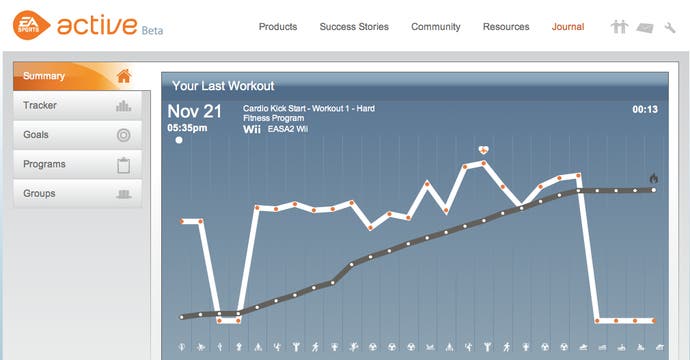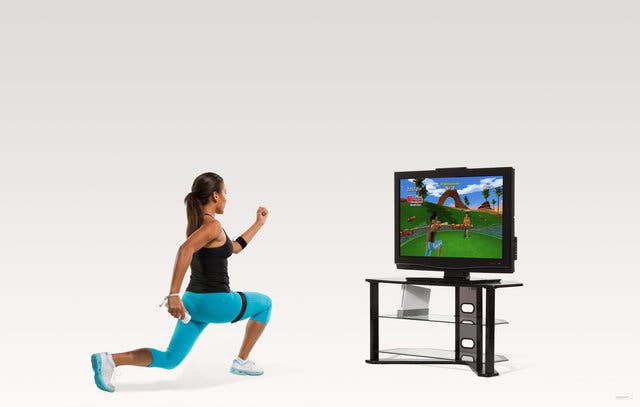EA Sports Active 2
Which format is fittest?
Publishers can wheel out as many fitness experts or frightful ex-popstars as they like – that alone cannot disguise the fact that building fitness requires weeks and months of serious effort and determination.
The original EA Sports Active understood this implicitly, mixing an impressive range of exercise techniques within a structure cleverly designed to keep you motivated when every fibre of your being was screaming "TAKEAWAY ON THE SOFA".
The 30-Day Challenge was the jewel in its crown: a month-long, varied, total body workout programme with clearly defined goals and a fantastic reason to pursue them: a measurable improvement in fitness at the end of it.
For those whose principal goal was to start taking their fitness seriously, both Active and its sequel, More Workouts, were in a class of their own. So the expectations for a full sequel have been understandably high. Not least because Active 2 marks the series' long-awaited arrival on PS3 and 360.
First let's look at what you get in the box. Each comes with a resistance band (which needs assembling – not necessarily easy for knot noobs). And each packs in a heart-rate monitor (360's is bulkiest in size and takes two AA batteries, the others a pair of AAAs).
That's it for 360 (assuming you already own Kinect). With Wii there's an additional leg sensor and USB dongle (to sync devices to the console), while PS3 has a leg sensor, dongle and a separate right arm sensor – Move isn't supported.
The big, unifying feature across all platforms is the heart-rate monitor. Strapped to your left arm, just below the elbow, this records pulse and beams the info to the console, which shows you on-screen how quickly your heart is beating – and, therefore, how hard you're working.
It's the game's major new feature and an important one. You might think you've been pushing yourself: now you know, in real-time, if you are. If you cheat a bit on an exercise, the movement sensors may not realise, but the pulse doesn't lie. You are cheating yourself and it's right there in your face.
The game explains clearly why this matters, splitting BPM into five 'zones' of effort from Rest (93 and under, for recovery and rejuvenation) all the way up to Full Throttle (168 and over, for maximising results in short, unsustainable bursts).
In between, there's good info on where you should be aiming to burn calories, improve fitness or strengthen the heart. As a motivating concept designed to help you muster an extra five per cent of effort, it's a terrific addition – when it works.
I've had problems on all three platforms with the heart meter periodically losing track of my BPM or displaying a resting pulse level while I'm almost passing out from exhaustion.

EA says clothing, tattoos and scarring can prevent the device from working properly. Without any of those obstacles I've still yet to find a consistent sweet spot where it works solidly without the need for readjustment.
It's by no means a deal-breaker and has certainly worked for me much more often than not. But it's frustrating when the game fails to register a massive effort.
Set-up in general can be a bit of a faff. Neither Wii's nor PS3's gadgets worked at first, so I had to go through the 'rebinding' process to reset them all before they would start flirting with the dongle. And since the Wii's USB slot is on the rear of the console, you may need to move it before a connection is established. Fortunately this should just be a one-off hassle.
Out of the box, the 360 version is the easiest to get going. The heart monitor, though a chunky brute, syncs in exactly the same way as other Xbox peripherals. And, unlike PS3 where they're strapped every-flippin'-where, if you get caught playing in your pants, it looks less like you're embroiled in a weird sex game.
Basic game structure is the same across the board. There's now a nine-week total body programme or a three-week cardio-focused course to choose from as a starting point.
Beyond that there's a large number of individual routines to choose from, and the facility to customise your own workouts from the 60-odd exercises featured.
Whatever your needs, there's probably an exercise for it, from straightforward cardio workouts, to strength routines for legs, arms, chest, back and so on.

Unlike the wafer-thin structure of Ubisoft's recent YourShape, everything you do in Active 2 feels as if it makes a meaningful contribution towards your individual goals.
Whether it's a scheduled workout or a random exercise squeezed in during some spare time, it's all tracked and added to your profile, with pages of graphs highlighting your progress in detail.
As with previous Active titles, there's an option to fill in dietary details and list activities completed outside of the game – hardly vital additions, but features that can still help simply by making you more conscious of your general lifestyle.
Set-up and online profile and stats are shared automatically with EASportsActive.com, where you can track progress and plan workouts wherever you have Internet access. Assuming EA's servers are actually working, that is. Over the past week across all versions, making a connection has been a roulette wheel of uncertainty. Last night I spent longer watching "Obtaining data from EA servers" messages going nowhere than I did actually working out.
The site's still officially in beta, so I'll give them the benefit of the doubt and assume this will be fixed, but it's clearly frustrating for a new user.
Feature-wise, it's the most comprehensive fitness game ever released. At the highest settings workouts can be brutal and exhausting – even causing mega-fit Olympic gold medal-winning cyclist Victoria Pendleton to work up a sweat during a recent press event. No mean feat.
But, in taking itself out of the Wii comfort zone and onto three platforms simultaneously, EA has over-exerted itself and the resulting performances are inconsistent to say the least. Here's a format-by-format breakdown.


